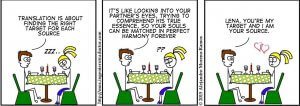While writing a full-blown compiler for a programming language is a difficult and frustrating task, writing a smaller and more specific parser can be surprisingly easy if you know a small trick.
On the other hand, parsing problems pops up at several places in modern-day programming. So, learning this useful trick can be rewarding.

Source: http://mox.ingenierotraductor.com/2015/12/translation-is-like.html
You will notice that Operator and Expression have no parent; they are independent terms.A grammar is read from the bottom up and different choices appear on distinct lines. Our grammar says that:
On the other hand, parsing problems pops up at several places in modern-day programming. So, learning this useful trick can be rewarding.

Source: http://mox.ingenierotraductor.com/2015/12/translation-is-like.html
Prerequisites
You need to know the basics of Python, more specifically, you should know the concepts of recursion and flow of control.Objectives
After reading and understanding this post, you will be able to create simple calculators, interactive interpreters, parsers, very limited and small programming languages, etc. In general, you should be able to take input, tokenize it, perform whatever actions you want to on the tokens, and output the result of the process.At the end of this post, you will have created a simple, Lisp-like prefix calculator. Following is a demonstration of how it's going to look:> ( + 3 2 )= 5> ( / 2 0 )DivisionByZero> ( - -3 2 )= -5> -2= -2> ( + ( * 3 2 ) 5 )= 11Step 1: Writing the Grammar
The first step to writing a parser is to write a clear grammar for its syntax. The grammar determines what is and what is not right. Once you have written the grammar, translating it to Python code is a trivial chore. The grammar will serve as our first pseudocode.For our tiny calculator, we know that the input can come in two forms: a Number (-2, .5, +8, 8.5, 9.) or a more complicated Expression begins with a (, followed by an operator, etc.).For writing a grammar, we need to identify different elements of the syntax. So far, we have Expression, Number, and Operator. The next important thing to do is to structure the elements (known as terms) into a hierarchical form. This is shown below:Expression:Number( Operator Expression Expression )Number:a floating-point number ([-+][0-9][*\.][0-9]*)Operators:| + |
| - |
| * |
| / |
- an Operator is one of +, -, *, /.
- a Number is a floating-point number which matches the RegEx [-+][0-9]*[\.][0-9]*
- an Expression is either a Number or a ( followed by an Operator, followed by two other Expressions, and finally ends in a ). Note that the definition of an Expression is recursive.
































